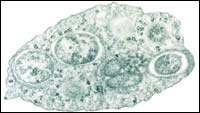Life Sciences and Chemistry
Articles and reports from the Life Sciences and chemistry area deal with applied and basic research into modern biology, chemistry and human medicine.
Valuable information can be found on a range of life sciences fields including bacteriology, biochemistry, bionics, bioinformatics, biophysics, biotechnology, genetics, geobotany, human biology, marine biology, microbiology, molecular biology, cellular biology, zoology, bioinorganic chemistry, microchemistry and environmental chemistry.

New findings on nerve cell proteins show promise for reducing disability
New findings in animals suggest a potential treatment to minimize disability after spinal cord and other nervous system injuries, say neuroscientists from Wake Forest University Baptist Medical Center.
“Our approach is based on a natural mechanism cells have for protecting themselves, called the stress protein response,” said Michael Tytell, Ph.D., a neuroscientist and the study’s lead researcher. “We believe it has potential for preventing some of the disability that occurs as a resul

Adaptive regulatory T cells suppress killing of persistently infected cells
Scientists report that they have identified a cellular mechanism that prevents the immune system from destroying chronic, incurable viral infections such as herpes, hepatitis and human immunodeficiency virus (HIV). The research, published in the March issue of Immunity, explains why critical immune cells fail to act against the viral infection and demonstrates a successful intervention that facilitates elimination of the virus. The results open up exciting new avenues for design of future antiviral t

Making noise about gene silencing
Advances in an area widely regarded in scientific circles as the ’next big thing’ – RNA interference (RNAi) – will be the major focus of a CSIRO-hosted conference on the Gold Coast in September.
The chairman of the ’Horizons in Livestock Sciences’ conference, CSIRO’s Dr Tim Doran, says RNAi research has major implications for plant, animal and human health.
“Since RNAi was first described in the 1990s, the technology has been rapidly adopted in laboratories

Antibiotics alter the normal bacterial flora in humans
Microbes researchers highlight drawbacks of antibiotics
Bacteria that are resistant to antibiotics can live in the human intestines for at least one year. Professor Charlotta Edlund from the Karolinska Institutet in Stockholm, Sweden, and Research Professor Pentti Huovinen from the National Public Health Institute in Turku, Finland, are keen to highlight the risks involved in the excessive use of antibiotics.
In their research funded by the Academy of Finland, the two profess

Dioxin-receptor network identified
A cell responds to pollutants – such as dioxin – via intricate and complex biochemical pathways beginning with the interaction of the pollutant molecule with a cell surface receptor. Christopher Bradfield and colleagues used yeast as a model system to elucidate the steps involved in the pathway that regulates vertebrate cell response to dioxin, the aryl hydrocarbon receptor (AHR) signal transduction pathway. To assess the molecules and pathways involved in the AHR pathway, the research group studied

’Male-killer’ bacterium’s genome is deciphered
Wolbachia have a thing against males. A member of one of the most diverse groups of bacteria, called Proteobacteria, this parasitic “endosymbiont” lives inside the reproductive cells of a wide variety of the nearly one million species of arthropods, including insects, spiders, and crustaceans.
Wolbachia’s effects range from beneficial to pathological, but if the host is male, the infection often turns out badly. The reason is the Wolbachia are transmitted through females, and to increase th